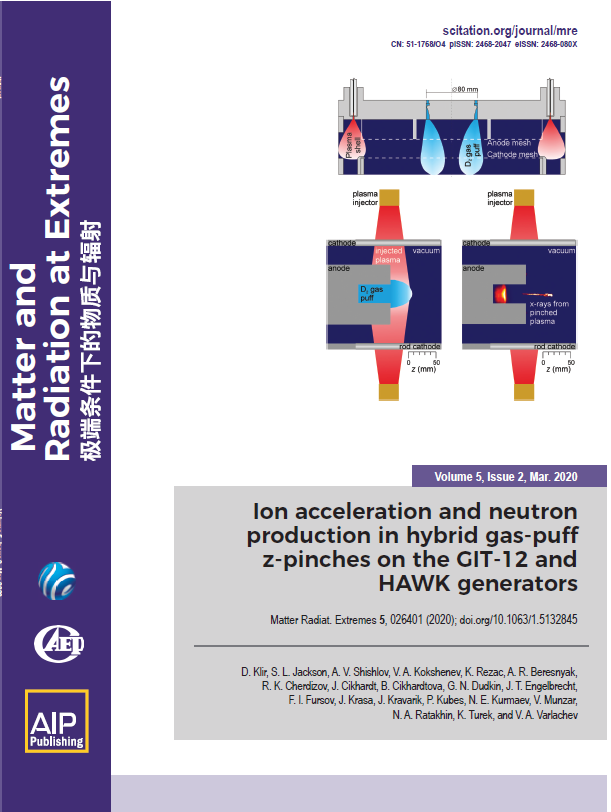Matter and Radiation at Extremes, 2020, 5 (2): 028401, Published Online: Apr. 1, 2020
Dynamically pre-compressed hydrocarbons studied by self-impedance mismatch
Figures & Tables
Fig. 1. Cartoon of the experimental setup, showing the hohlraum and the target package, consisting of Al–Au–Al layers attached to the CH sample. The driving radiation temperature is monitored on the XRD cameras, and shock propagation data are taken on the VISAR system.

Fig. 2. Examples of the measured radiation temperature incident on the ablator surface as a function of time for the cases of a single and a double shock. The shaded uncertainty is the variation in measured temperature between the cameras. The lineouts correspond to the temperatures in shots 302 and 315, respectively (see Table I in the Appendix ).

Fig. 3. Plastic target density, simulated using the double-shock radiation profile in the radiation hydrodynamics code HELIOS, with SESAME equation of state 7592 for polystyrene. The radiation is incident from the left-hand edge onto the ablator; the shock passes through this and into the CH, the boundaries of which are marked by the black lines. The coordinates are Eulerian, allowing the different shock-front velocities to be observed.

Fig. 4. VISAR data, calculated velocities, and corresponding reflectivity values. Between t 1 and t 2, the value is equal to the apparent particle velocity u app, while the higher velocity from t 3 to t 4, seen only on one of the VISAR arms, is due to the merged shock u s ,m . The reflectivity values show a rise after the first shock enters the plastic, possibly due to changes in the Al–CH interface, with the horizontal dashed line showing the theoretical Al–plastic reflectivity of 88%. The flat region of nonzero reflectivity between t 2 and t 3 provides the reflectivity value for the double-shocked state. The data are from shot 315 (see Table I in the Appendix ).

Fig. 5. Example of the self-impedance mismatch technique illustrated on the P -u p plane. The double-shocked state P2 is determined by the intersection of the Rayleigh line from the single-shocked state P1 and the release line of the final state P3. The uncertainty in the Rayleigh line, indicated by the shaded orange area, is due to the uncertainty in the transit time, and hence the shock speed u s ,2, while the shaded gray area is due to uncertainty in the merged shock velocity u s ,m , and hence the final state. The uncertainties in pressure and density are taken from the intersection of the shaded areas, and are particularly large for the density ρ .

Fig. 6. Pressure–temperature phase diagram, showing the conditions reached on the Hugoniot (red triangles and dashed line), and with the double-shock drive (green squares and dot-dashed line); the highest-pressure point on the Hugoniot is omitted so that the lower-temperature results can be distinguished. Also shown are the conditions where diamond formation from double-shocked CH was observed by Kraus et al. 1 (blue diamonds), the expected melting line of diamond from Wang et al. 20 (blue dashed line), and the hydrocarbon demixing boundary from Gao et al. 21 (black dotted line).

Fig. 7. Reflectivity of shocked polystyrene as a function of (a) pressure, (b) density, and (c) temperature, all taken with probing wavelength λ = 532 nm. The red triangles show points on the Hugoniot, either from single shocks or from the final-state merged shocks, while the green squares show double-shocked conditions. The closed and open green squares show reflectivity values before and after correction, respectively, as described in the text. The blue crosses are results from the OMEGA facility, taken from Barrios et al. 11 The disagreement at high pressures is likely due to a systematic offset in the initial reflectivity, as this was not measured prior to the shot.

Fig. 8. Example showing reflectivity for the single-shock shot at 362 GPa (shot 302 in Table I in the Appendix ), as measured on each arm of the VISAR system, and assuming that the initial reflectivity is equal to the theoretical reflectivity of Al, equal to 88% (black dashed line). The reflectivity in the shocked region is equal to 53% ± 3%, with the uncertainty being due to the different values from each arm and to uncertainty in the fitting to the initial Al value. The gray dotted line indicates the maximum reflectivity expected from the QMD theoretical results.

N. J. Hartley, C. Zhang, X. Duan, L. G. Huang, S. Jiang, Y. Li, L. Yang, A. Pelka, Z. Wang, J. Yang, D. Kraus. Dynamically pre-compressed hydrocarbons studied by self-impedance mismatch[J]. Matter and Radiation at Extremes, 2020, 5(2): 028401.



